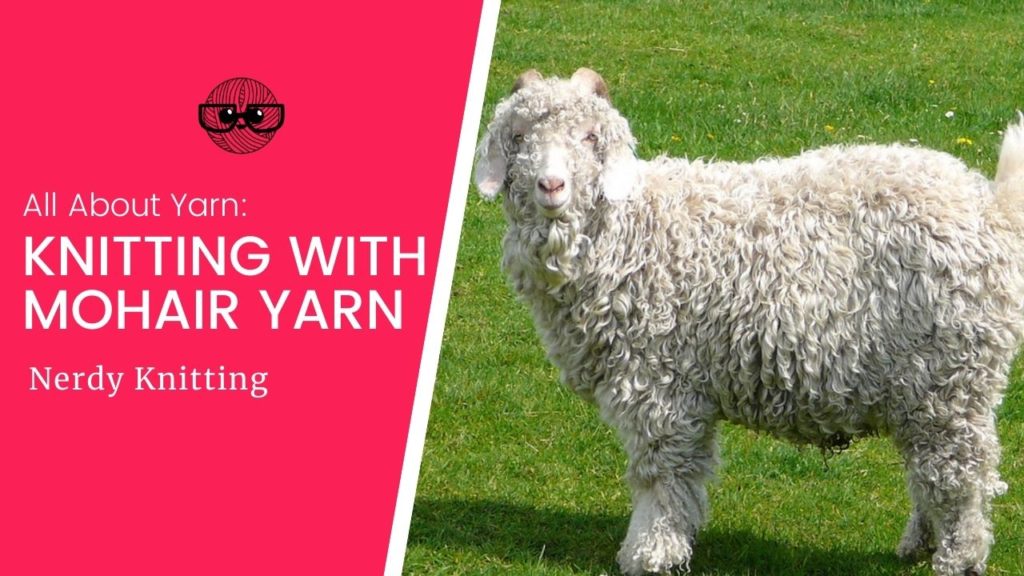Mohair is one of those special yarns to knit with. But, before you purchase that expensive mohair yarn, there are some facts you should know so you’ll enjoy knitting with mohair, avoid some common concerns, and know how to properly care for your beautiful finished garment.
In this article we’ll look at some of the important things you need to know about knitting mohair yarn:
- A Look at Mohair
- Properties of Mohair Yarn
- Knitting with Mohair Yarn
- Choosing Knitting Patterns
- Caring for Finished Projects
- Buying Mohair Yarn
- More Questions about Knitting Mohair Yarn
To help you know when mohair is a great choice for your next project – we’ll look at all of these common questions in the sections below.
Some links below are affiliate links. If you click through and make a purchase I may receive a small commission at no extra cost to you. See the disclosure policy for more information.
A Look at Mohair
Fibers and fleeces used for knitting can be divided into four broad categories – animal fibers (like wool, silk, and alpaca), plant fibers (like cotton and linen), biosynthetic fibers (like rayon and bamboo), and synthetic fibers (like acrylic and nylon). Mohair falls within the animal fibers category because the fiber comes from the Angora goat. It also falls within the ‘specialty wool’ category because, while it’s considered ‘wool,’ it doesn’t come from sheep.
This beautiful fiber comes from the fleece of the Angora goat, which most likely originated in the Himalayas but was traditionally raised in Turkey. Today, South Africa is the large producer with the United States (specifically Texas) in second place. The goats are sheared twice a year and, interestingly, they produce a single coat of fine wool (most wool-producing animals have double coats).
The fleece sheared from older goats is coarse and often used for upholstery. One interesting fact – it was used for upholstery before commonly used synthetics for things like theatre and train seating because it is a tough fiber that can stand up to hard use. The fleece that’s commonly used in knitting comes from the Angora kids (young goats) and the fiber is known as kid mohair, which is the softest and finest grade of mohair. This also makes the mohair used for knitting an expensive fiber – because it only comes from young goats.
Mohair fibers are 4-12 inches long with fewer scales along the shaft than wool, making it smooth and lustrous. This also means it won’t felt as easily as wool (those scales on wool fibers are what causes it to felt so readily). But this smoothness also means it needs to be tightly spun so it won’t fall apart. Instead, it’s often spun as a ‘brushed’ fiber with a halo or fuzziness.
Another interesting fact about mohair is that the cortex (the middle of the hair shaft) contains air pockets. This makes the fibers very lightweight as well as making them very good insulators – so mohair is a great choice for garments that will keep you warm in cold weather.
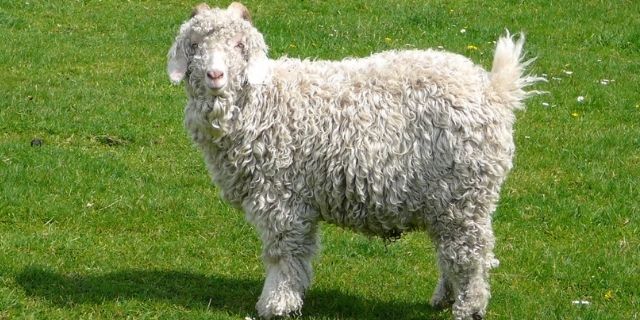
Properties of Mohair Yarn
Mohair is considered a luxury yarn – with good reason. It’s nice to knit with (if you don’t find it scratchy), can be easily blended with other yarns, and can be used for many different projects. See the first list below to understand the advantages to knitting with this yarn.
But sometimes you’ll want to skip using mohair yarn. It has certain disadvantages that you should know before you start knitting (see the second list below). You certainly don’t want to begin a project only to discover that your expensive, beautiful yarn just isn’t right for the project you’ve chosen.
Advantages of Mohair Yarn
Mohair yarn shares many of wool’s properties and has some clear and distinct advantages that make it a welcome addition to a yarn blend. Mohair is:
- very lightweight
- warm and insulating
- has nice drape
- hard wearing
- receptive to dye
- easy care
Disadvantages of Mohair Yarn
While mohair is a wonderful addition to yarn blends (it’s especially nice when used in a project for cold weather – it’s just holds in the warmth so beautifully). But it does have a few disadvantages:
- less resilient than wool
- can feel prickly
- sheds if lightly spun
- expensive
- difficult to ‘frog’ or fix knitting mistakes
While there are only a few disadvantages, they can be hard to overcome. Someone with sensitive skin, while they can appreciate the additional warmth that mohair brings to a yarn blend, they may not enjoy the feel of the yarn – it can feel prickly. If that’s the case, and you really want to use a mohair blend, choose projects where there won’t be direct contact with the skin (like a cardigan). You can get the warmth and brushed mohair softness without any of the scratchiness.
Another thing to note is that it’s hard to see your mistakes while knitting (which could also be an advantage – if you want to hide those mistakes) – especially in regards to brushed mohair yarns. This makes it difficult to drop down and fix errors, because they are hard to see and fix, and also because brushed mohair has a ‘stickiness’ to it that makes it hard to ‘frog’ your knitting or drop down to fix stitches.
Get the Yarn Substitution Checklist
Fill in the form below to get a free copy of the Four Step Checklist for substituting yarn. Use it for your next knitting project!
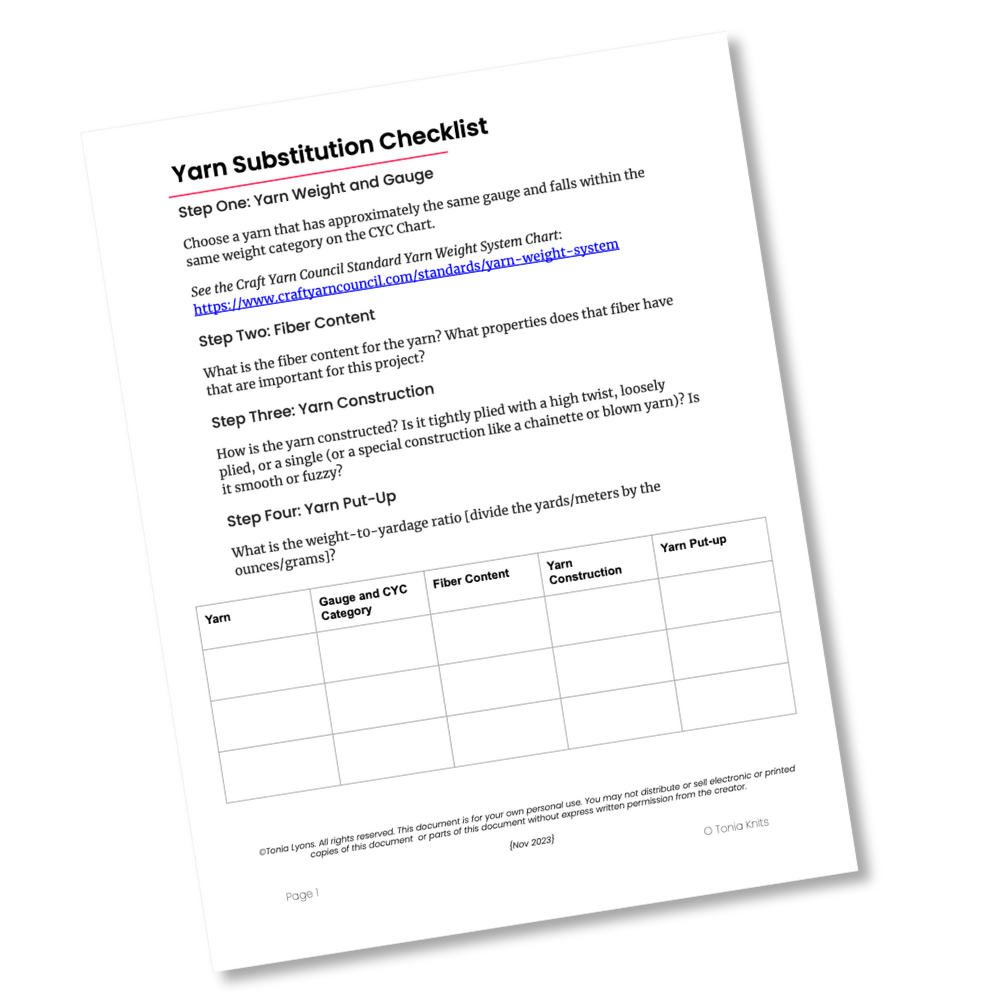
Knitting with Mohair Yarn
Knitting with mohair is either a love or hate experience. Those that love it, love it for its lofty feel, softness and warmth. But those who think it feels scratchy or prickly may not enjoy knitting with this yarn. This is especially true of brushed mohair. But if mohair is blended with other fibers in a less fuzzy yarn, this may not be an issue.
Brushed mohair has its own rules when knitting with it. While it’s often blended with a lace weight silk or nylon (so it falls within the lace weight category), that doesn’t mean you should knit the yarn on small needles like you might for normal lace weight yarns. Instead, you usually want to knit on larger needles (US 3 – 8 or 3.25 – 5mm) – to give the lofty, brushed fibers room to expand.
Brushed mohair is also commonly held double with another yarn. This is generally done to add a soft halo and additional warmth to the final project without adding any additional weight (mohair is very lightweight and a great insulator).
But beware difficult patterns or fixing knitting mistakes if you’re using brushed mohair, which has an inherent ‘stickiness.’ Because the yarn is brushed, it’s hard to see mistakes and the ‘stickiness’ makes it difficult to ‘frog’ your work or drop down and fix stitches.
While brushed mohair can feel sticky, because it’s often blended with silk, you may notice that your stitches slip and slide on your knitting needles (especially if you’re using metal needles). If you’re noticing that your stitches feel slippery and your tension isn’t consistent you may want to choose blunt-tipped wood, bamboo, or plastic needles (or any needles with a bit of ‘grip’). The blunt tips will keep you from splitting the yarn, the material of the needles will keep your stitches from slipping and sliding on your needles, and it will most likely improve your tension issues.
While I far prefer knitting on metal needles, when I’m knitting something that has a tendency to slip around (like mohair and silk), I usually choose wood or plastic needles instead.
One final caveat – mohair can shed. Because it’s a soft fiber with few scales it’s more difficult to spin (scales in wool are what makes it sticky and more likely to felt but it also makes it easy to spin into useable yarn). That’s why it’s almost always combined with other fibers. But if the yarn is lightly spun, the mohair fibers are more likely to shed. The more tightly spun the yarn, the less likely it will shed.
Discover the Confidence You Need to Fix Your Knitting Mistakes
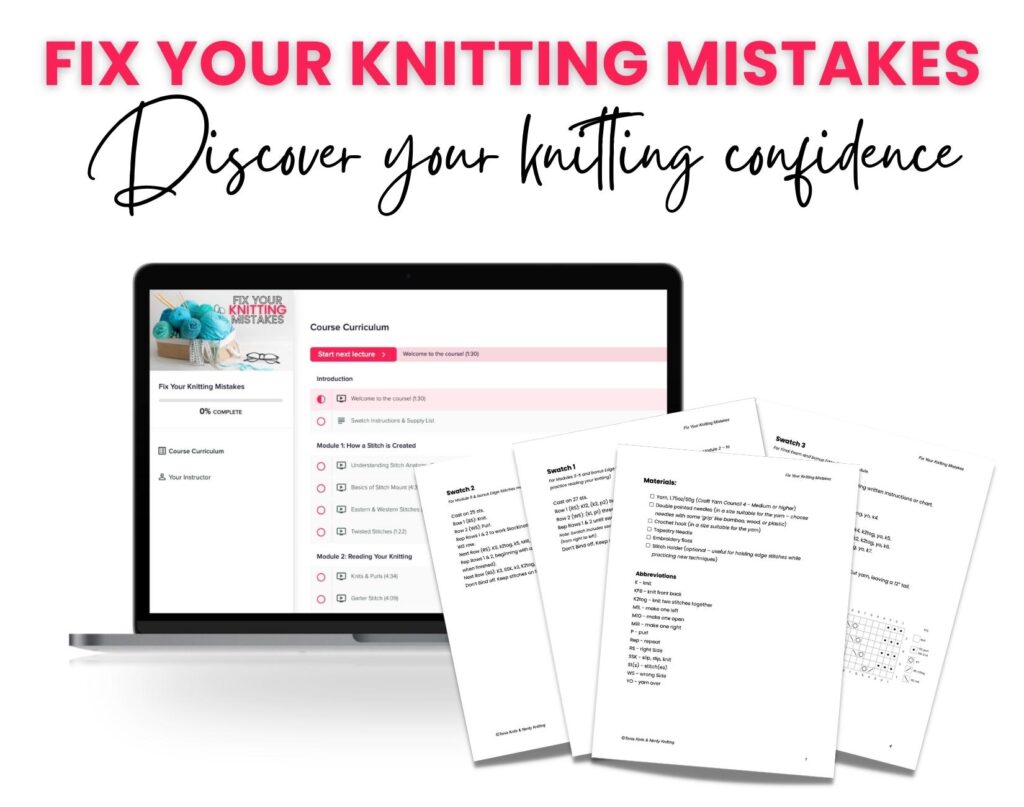
By the end of this six-part self-paced course, you’ll be able to read your knitting, recognize a variety of knitting mistakes, and understand how to fix them.
Choosing Knitting Patterns
Mohair is a wonderful choice for plenty of projects – but it depends on how you want to use it. The most common brushed mohair is a versatile yarn – used on its own or paired with another heavier weight yarn.
If you’re using a brushed mohair, you should know that stitches will have a less-defined, fuzzy appearance. While this isn’t necessarily a drawback – it might be a feature you are looking for – it’s something to be aware of. You may want to pass on the highly textured, detailed pattern where the stitches will get lost in the haze of a brushed mohair yarn.
Fuzzy mohair yarns look best in simple stitch patterns – Garter stitch, Stockinette stitch, and other simple stitch patterns (you could even do some basic lace patterns – just be aware that the fuzzy nature of mohair will make your stitches less-defined).
But all forms of mohair yarn and yarn blends can be used in shawls and wraps, garments, or accessories. It adds wonderful warmth to garments (so it’s not a great choice for summer garments) as well as a lightweight feel.
Along with summer garments, it’s not a great choice for anyone with sensitive skin (especially if the project will be touching the skin – like a cowl or hat) or who find the feel of mohair scratchy or prickly. If you really want to use mohair and you’re knitting for someone with sensitive skin, choose projects that won’t come into direct content with their skin (like a cardigan).
Caring for Finished Projects
Mohair is surprisingly easy to care for. Soil and dirt is easy to remove and, because it has fewer scales than wool it doesn’t easily felt. While you’ll still want to treat the wet fibers with care, you don’t have to be as careful as you would for a wool garment. In most cases, hand washing with a mild detergent and placing the project on a mat or towel to dry is a good choice. Of course, you should always check the label of your yarn for the specific care needs.
If your garment just needs a quick refresh, a hand-held garment steamer or a clothes iron set to medium can be used to freshen it up (but test this on a small swatch first – just in case!). Just place the garment on a flat surface and run the steamer slowly over the surface. If you’re using a clothes iron – never press the iron on the garment – just use the steam feature, holding the iron about an inch or so away from the fabric.
Hand washing mohair yarns: Fill a small basin with cool to lukewarm water and a little mild detergent. Submerge the garment in the liquid, carefully using your fingers to dislodge any stains. Let the garment soak for a few minutes (up to about 30 minutes, if you want).
To rinse the garment, hold it to one side of the basin as you drain the water and add fresh water. When you’re ready to dry the garment, lift it gently from the water and carefully squeeze out the water. Place the garment on a towel, roll it up, and press out the excess water.
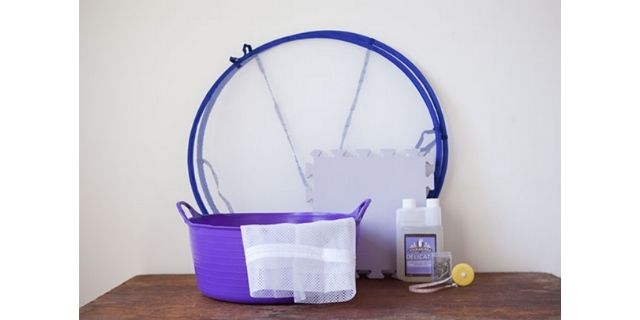
How to Block Mohair Knits
Hand washing and then placing the finished project on a flat surface (on a mat or towel) is all you need to do in most cases – and it could actually be considered ‘blocking’ in the broadest sense of the term.
Wet-blocking mohair yarns: After washing and pressing out the excess water with a towel, place the garment on a dry towel or mesh sweater dryer and place it in its final shape, stretching any lace or other openwork designs to showcase them.
Buying Mohair Yarn
Mohair can be found in a wide variety of yarn blends. It’s very common to find brushed mohair combined with a lace weight silk or nylon – which provides a strong, solid core for the yarn. In this form it’s often used to create a fluffy halo in a garment – either on its own for an accessory like a cowl or held double with another yarn. But it can also be blended with other fibers. You’ll commonly see it blended with wool but it can also be blended with other fibers as well – cotton, acrylic, and more.
You’ll find three sections below – brushed mohair in lace weight yarn, mohair and wool blends, and some other mohair blends that use other fibers.
Brushed Mohair
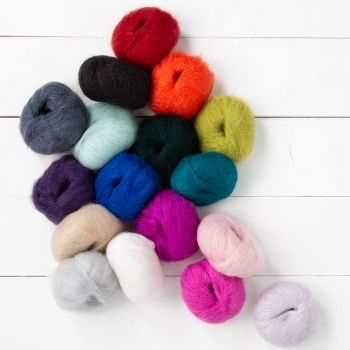
Mohair is most often spun into a ‘brushed’ yarn that has a soft, fuzzy halo and blended with lace-weight silk or nylon. And, while it falls within the lace weight category because of the fiber it is spun with, it’s not recommended to use the same size needles as you would for lace yarns. Instead, you’ll use larger knitting needles to allow room for the halo to expand.
It’s also commonly used in knitting patterns where the lace weight mohair yarn is ‘held double’ with another yarn. This is usually to add softness and a halo to the finished project.
If you’re looking for a lace weight brushed mohair yarn for your project, these are good choices:
- Knit Picks Aloft Super Kid Mohair (also available in hand-painted colorways)
- Rowan Kidsilk Haze
- Debbie Bliss Angel
- Lang Yarns Lace
- Willow & Lark Plume
Mohair & Wool Blend Yarns
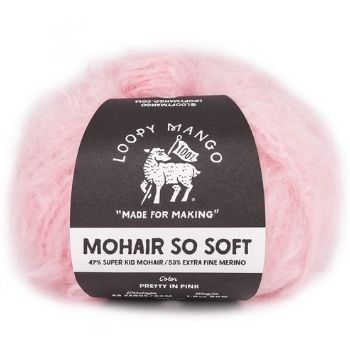
Mohair can also commonly be found blended with wool in a variety of yarn weights. It adds a lovely softness and additional warmth to finished projects. Here are some mohair and wool blend yarns to consider for your next knitting project:
- Knit Picks Bare Surefoot Sock Yarn
- Knit Picks Bare Merino & Mohair
- Rowan Kid Classic
- Loopy Mango Mohair So Soft
- The Fibre Co. Cumbria
Other Mohair Blends
While brushed mohair is very popular and mohair/wool blends are common, there are plenty of other choices as well. Here are some mohair blends in various yarn weights that might pique your interest:
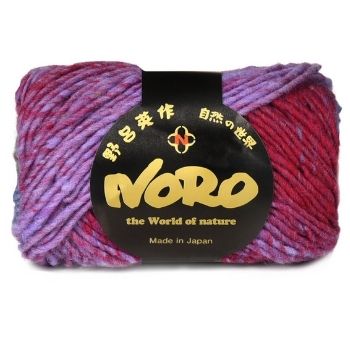
- Noro Silk Garden (mohair, silk & wool blend)
- Sirdar Temptation (acrylic & brushed mohair blend)
- Rico Luxury Magic Mohair (polyester, mohair, nylon & wool blend)
- Noro Akari (silk, cotton, viscose & mohair)
- Plymouth Yarn Johanne (wool, mohair & acrylic)
More Questions about Knitting Mohair Yarn
While you’ll find most of your questions addressed above, sometimes you just want a quick answer to your question. You’ll find some of those commonly asked questions right here:
What size needles for brushed mohair?
While brushed mohair yarns are often considered lace weight, you should use larger needles to allow the brushed halo room to expand. US 3 – 8 or 3.25 – 5mm are the knitting needle sizes to consider for your project.
Alternatively, lace weight brushed mohair can be held double with another yarn. In that case, use the needle size recommended for that particular yarn.
What is mohair yarn good for?
Mohair is a versatile fiber with many uses. It’s lightweight and warm, making it a great choice for winter garments. Brushed mohair is useful for fluffy cowls and accessories or held double with another yarn to provide additional warmth along with its pretty halo.
Does mohair yarn shed?
Because it is a soft, smooth fiber without many scales to make it stick together, it can shed – especially if it’s a brushed mohair that is lightly spun. A tightly spun yarn is less likely to shed.
What’s the difference between mohair & cashmere?
Mohair comes from the Angora goat, native to Turkey but now commonly raised in South Africa and the United States. Cashmere comes from the Kashmir goat that is native to the Himalayas.
How do I take care of a mohair sweater?
Mohair garments should be hand washed in a mild detergent.
- Fill a small basin with cool to lukewarm water with a small amount of mild detergent.
- Add the garment, pressing to submerge.
- Use your fingers to gently work out any dirt or stains.
- Let the garment soak for up to 30 minutes.
- Holding it to one side, drain the water and add some fresh water to rinse out the detergent.
- Gently squeeze the excess water from the garment and place it on a towel.
- Roll it in the towel to remove more water.
- Place on a second towel to dry.
Now that you know all the facts about knitting mohair yarn, you’re ready to confidently choose the right knitting projects and the right yarn for your project. For more information about various fibers, fleeces, and yarn sources, take a look at the resources and articles linked below.
More About Yarns & Fibers
- The Knitter’s Book of Yarn by Clara Parkes (available at Amazon)
- Yarn Substitution Made Easy by Carol J. Sulcoski (available at Amazon)
- The Fleece & Fiber Sourcebook by Carol Ekarius & Deborah Robson (available at Amazon)
- Luxury Yarn One-Skein Wonders by Judith Durant (available at Amazon)
Related Knitting Articles
- Knitting with Silk Yarn: Everything You Need to Know
- All about Knitting with Alpaca Yarn (& Llama & Vicuña Yarn)
- Knitting Cashmere Yarn: What You Need to Know
